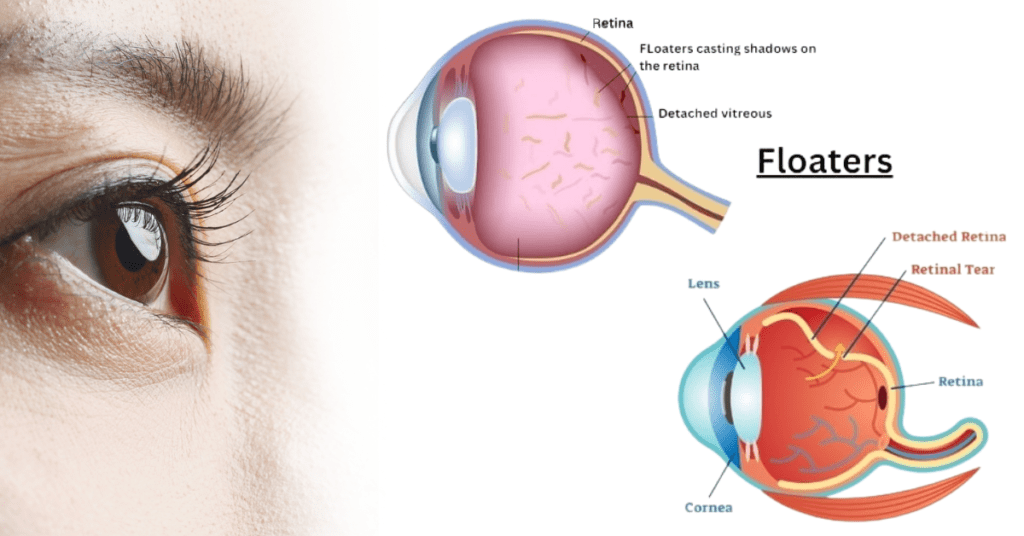A small speck drifts across your view. It happens suddenly. You might see it while looking at a white wall. Maybe you see it against a clear sky. This event can be unsettling. It raises an immediate question: Is this just a nuisance? Or is it a sign of danger? These visual disturbances are commonly called floaters. Most floaters are completely harmless. They are a common part of the aging process. But a sudden, dramatic change in vision is different. It is a signal that demands professional medical checks. Ignoring a serious ocular symptom risks permanent sight loss. We explain how to tell the difference. This article helps you triage your symptoms accurately. It emphasizes when to seek emergency care.
Understanding What Floaters Are
The eye is mostly filled with a clear substance. It is a jelly-like material called the vitreous gel. This gel keeps the eye’s shape stable. Floaters are tiny pieces of debris suspended in this gel. They are small clumps of protein or old cellular remnants. These tiny particles create shadows on your retina. At the back of your eye is a light-sensing tissue known as the retina. Your brain perceives these shadows as floating shapes. Shapes are cobwebs, strands or tiny black spots in vision. They almost fly away when you approach to look at them. Keep in mind, they are not on the surface but in the middle of your eye.
Common Causes of Sudden Black Spots
The most frequent cause of new spots is a natural process. This is the aging of the vitreous gel. The gel naturally liquefies and shrinks over time. This shrinking pulls the gel away from the retina. This event is called Posterior Vitreous Detachment, or PVD. PVD often releases a larger piece of debris. This is when you might notice a single, prominent, sudden large black spot in vision. PVD is usually benign but must be confirmed by a doctor. Chronic eye strain can also cause temporary visual sensitivity. This often happens due to excessive screen use. Consider changing your screen settings.
You can read about “Does Dark Mode Really Help Your Eyes Feel Better?” for better screen habits. If your vision feels off, you may need an updated prescription.
When Sudden Black Spots Mean Serious Trouble
A true and significant change is an immediate red flag. This happens when the spots are not simple floaters. This condition demands that a doctor see you immediately. The most dangerous cause is a retinal tear. The pulling of the vitreous gel can rip a hole in the retina. This tear often severs a small blood vessel. The resulting bleed appears as a massive shower of dark specks. This can look like soot or pepper falling. If you experience this severe visual change along with a headache, it is urgent. Severe, sudden black spots in vision not floaters with headache, could signal a vascular event.

If you see sudden black spots in vision not floaters migraine is a common cause, but an underlying retinal issue must be excluded first. In very rare cases, a sudden black spot in vision not floaters a stroke affecting the visual area, can cause sudden shadows. Any new floater, a sudden black spot in vision or floaters in a child must be investigated. PVD (Posterior vitreous detachment) is highly uncommon in young, healthy eyes.
Symptoms That Should Never Be Ignored
Never wait to see an eye doctor if you experience these signs. They signal a potential emergency. The first critical sign is a sudden onset of flashes of light. These are described as streaks, sparks, or lightning bolts. They occur when the vitreous tugs violently on the retina. Flashes mean the retina is being stimulated abnormally. This often happens right before a tear forms. The second sign is the visual curtain or veil. This is a shadow that moves across your field of view. It often starts from the side and dramatically blocks sight. This is the most prominent symptom of a retinal detachment. The retina is peeling off behind the eye. This is when emergency surgery is necessary to save your vision. Immediate action is crucial to preserve usable vision.
Treatment Options for Floaters and Serious Conditions
The majority of benign floaters do not need any formal treatment. The brain normally becomes trained to disregard them with time. The debris is also likely to accumulate at the base of the eye. In cases of severe, debilitating floaters, the operation known as a vitrectomy may be a possibility. This is a surgical procedure. The vitreous gel is carefully removed. It is replaced with a clear saline solution. This action successfully removes the floating debris. For a retinal tear detected early, the treatment is simple and fast. A doctor uses a laser or cryotherapy (freezing). This process seals the tear. It prevents fluid from passing under the retina and causing detachment. This simple step is sight-saving. Sudden black spots in vision not floaters treatment depends entirely on the root cause.
You can learn about getting an “Online Eye Exam for Glasses” to check your lens power. A professional checkup is the only way to rule out serious issues.
Living with Floaters — Coping and Adjustment
Coping with persistent but harmless floaters is often necessary. They become less bothersome with time. You must avoid staring directly at them. Instead, look away and then back slowly. This helps push the floater out of view in the center. Wear polarized sunglasses when out in the sun. Polarized lenses eliminate glare and enhance contrast. Due to this, internal debris is less visible against a bright background. Maintain your general health. Keep blood pressure and sugar in check. This safeguards the small, fragile blood vessels of your retina. The antioxidant diet also helps the eye. Regular eye checkups are your absolute best defense. An eye doctor monitors any existing floaters. They watch closely for any critical new changes. A yearly dilated eye exam is highly recommended for everyone over 50.
Conclusion
In the majority of cases, floaters are a nuisance. They are usually harmless constituents of the process of aging. However, an abrupt radical shift in perspective cannot be ignored. Immediately consult an eye test when new flashes or shadows appear. The secret to the prevention of permanent vision loss is early detection. Your eyesight is invaluable. Prioritize your ocular health immediately.


